Published
on 22
Feb 2018
|
All rights reserved.
|
|
|
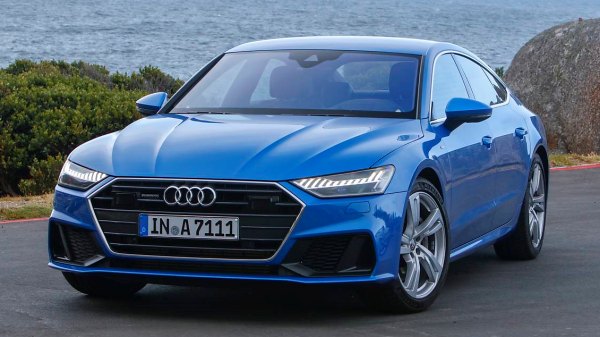
|
|
The
new A7 is an alarming signal that needs the company management to pay
attention...
|
|
The
second generation Audi A7 continues the strategy of luxury 4-door
coupe, a kind pioneered by Mercedes CLS-class in 2004. This is a niche
segment in which only 3 contenders exist (BMW 6-Series Gran Coupe is
the other). Their combined sale volume is well below 100,000 units
globally. In 2016, the A7 registered just over 26,000 sales, while BMW
managed about 10,000 (Mercedes did not offer standalone figure for CLS,
although it might be slightly higher than Audi). To make them
financially viable, they have to be derived from their companies’
E-segment sedans. In the case of A7, it is A6.
The current A6 is about to be replaced, so it is not surprising to
learn that the new A7 sits on the next generation A6 underpinnings. It
is also closely related to A4 and A8, as all of them are based on the
MLB Evo platform. When we say platform, we mean the mechanical layout,
electronic architecture as well as key component set rather than the
exact chassis. While A8 enjoys the most sophisticated aluminum
spaceframe with carbon-fiber reinforcement, both the A7 and A6 are
settled with more conventional materials (mainly high-strength steel,
plus some aluminum chassis parts and aluminum suspensions) like the
smaller A4. There are not many surprises in the use of technology, as
we have already seen the engine range and Quattro
Ultra system on the A4, as well as the 48V electrical system,
4-wheel steering, air suspension, semi-autonomous driving technology
and touchscreen-based infotainment system from the A8. The wow-factor
is rather limited.
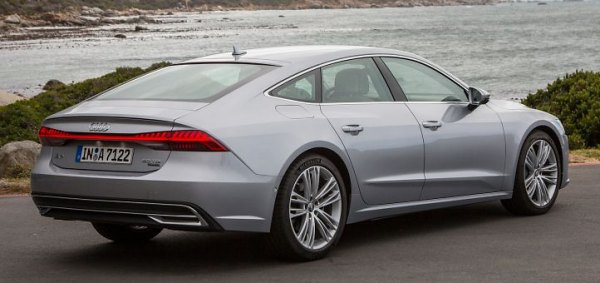
|
|
Size
remains unchanged, but the new design is a bit less beautiful.
|
|
The biggest selling point
of A7 is looks, of course. While the car is virtually the same size as
its predecessor at 4969mm long, 1908mm wide, 1422mm tall and 2923mm in
wheelbase, it has adopted the company’s new design language which
sports a sharper hexagonal grille and angular nose. In my eyes, those
angular elements are perhaps over the top, because they serve to make
the car different rather than more beautiful. The sleek side profile is
largely carried over, but the tail is raised by 30mm thus the fastback
does not drops as dramatically as before. The slimmer, full-width LED
taillights don’t look as sporty as the old ones. Overall, you may be
still attracted by the car’s sleek proportion, but the new Mercedes CLS
looks a more elegant sculpture, and I guess the next BMW 8-Series Gran
Coupe would be more stylish, judging from the 2-door concept.
Inside, the A7's cabin design is largely taken from the A8, especially
the dashboard architecture with twin-touchscreen at the center console
area – the upper one is for infotainment system while the lower one is
for climate control etc. The instrument is a 12.3-inch TFT screen which
doubles as the satellite navigation screen. Tech fancies will like the
touchscreen control’s intuitive menus and haptic feedback, although in
practice it is more difficult to access than the old MMI control while
you are driving. As for space, the rear seat gains 21mm legroom and 5mm
headroom, so it is spacious enough for two adults – just. Materials and
build quality of Audi has always been high, and the A7 is no exception.
It just feels a bit too cold and business-like, lacking the sense of
occasion of Mercedes cabin designs.
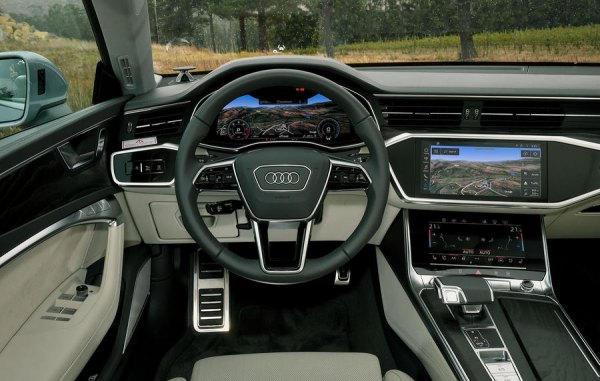 |
|
A8
donates vast of technology to its cabin. |
|
All A7 models run 48V mild hybrid system as standard, which recoups
braking energy for coasting and automatic engine stop-start. The
launching engines are the familiar 340hp 3.0 TFSI single-turbo V6 and
286hp 3.0 TDI V6. The former is smooth and more refined, offering good
if not outstanding performance (0-60 in 5 seconds). The diesel is
slightly more vocal and less willing at the top end, of course, but it
feels stronger at the bottom end. Want a V8? Then you had better to
wait for the S7. The 3.0 TFSI is mated with 7-speed S tronic gearbox
and the part-time Quattro Ultra system. The diesel engine is too
torquey for them, thus it needs ZF 8-speed automatic and permanent
Quattro.
The traditional Quattro layout puts the engine completely ahead of the
front axle thus results in less than ideal weight distribution.
However, on a car as large and heavy as the A7, the adverse effect is
relatively small. This is especially true as the high-end car has many
optional equipment to regain the lost ground, such as 4-wheel steering
and torque vectoring sport differential. Moreover, it offers 4 choices
of suspension: standard setup, 10mm-lower sport suspension, adaptive
damping and air suspension, although it doesn’t have the AI Active
suspension of A8. A fully equipped A7 has its body motion well
controlled and understeered well managed. However, like most big Audis,
it is never exciting to drive. The steering feels like playing video
games although its response is accurate. The car doesn’t feel as agile
or as sharp to turn-in as its coupe looks suggested. Its chassis tuning
is simply too safe, just like a luxury limo.
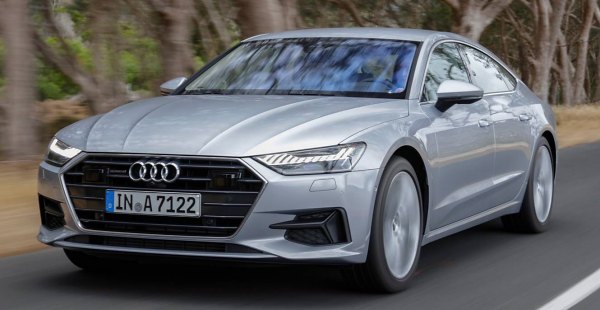 |
|
Chassis
tuned like a luxury limo, but the ride is certainly not.
|
|
But the ride quality is
certainly no limo-grade. On the best looking 21-inch wheels, even with
the most sophisticated air suspension installed, it rides harshly over
sharp bumps. Even on 20-inch wheels and with the suspension set to
Comfort mode, it still rides more stiffly than a luxury coupe is
expected to be on anything other than the smoothest highway. This means
it is not qualified to be a good cruiser. In terms of dynamics and
refinement, the new A7 is less than the sum of its classy components,
and it is a big disappointment indeed.
Over the past decade or so, Audi has been consistently fighting uphill
to close the gap between itself and its German rivals. The last
generation R8, RS4, RS5, A4 and A6 were all close to the excellence of
BMW and Mercedes, and in some cases better. Unfortunately, maybe due to
brain drain or the shift of focus to autonomous technology, the trend
has taken a U-turn in the latest generation of Audis. Now they are
boring to drive and to look again. The new A7 is an alarming signal
that needs the company management to pay attention. If this trend
continues, Ingolstadt will slip further behind in the chase for the
world’s largest premium car maker.
|
Verdict:    |
Published
on 31
May 2019
|
All rights reserved.
|
|
Audi S7 TDI
|
|
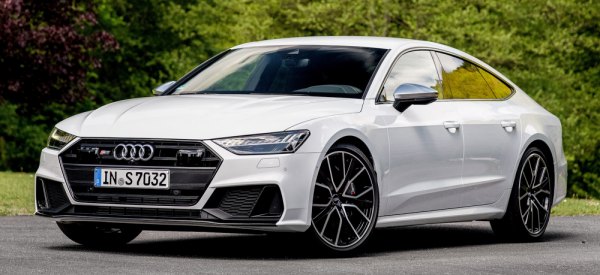
|
|
There
is nothing wrong with TDI power. The problem lies on the badge.
|
|
A good-looking,
long-legged luxury car. Its liftback can swallow quite a lot of
luggage. It will do 0-60 mph under 5 seconds. It will cruise quietly on
highway. Its suspension is slightly firmer than its sedan sibling, but
not overly firm for a coupe. Quattro gives it very good roadholding and
all-weather security. Rear-wheel steering makes it feel more agile than
you might expect for a car so large (just under 5 meters long) and so
heavy (over 2 tons). Even the steering, a traditional weakness of Audi,
is more pleasurable to engage here – responsive, consistent and well
weighted.
The problem lies on its badge: S7. When it starts with the letter “S”,
you would expect more thrills, more speed and more sharpness. From this
perspective, the 3.0 TDI V6 falls short of expectation. Although its
output is remarkable by diesel standard, 349 horsepower is not great
for a 2-ton performance car. 516 pound-foot of torque is more
appreciated, but the torque band is quite narrow, spanning between 2500
and 3100 rpm. At lower revs, not even the 48V electrical supercharger
can mask the turbo lag. It is not as bad as a traditional big turbo
engine, but you don’t get the instantaneous response a performance car
deserved. At the other end of the spectrum, the diesel V6 feels flat,
reluctant to rev much beyond its surprisingly low, 3850 rpm power peak.
The background rumble produces by the exhaust sounds good, but it never
brings the same thrills as a good gasoline engine.
The 8-speed automatic also leaves a lot to be desired. In automatic
mode, it sometimes hesitates, seems wondering which gears to be
selected. We don’t expect this to happen on the marvelous ZF 8HP, but
Audi’s calibration seems to have difficulties to deal with the high
torque and the intervention of electric charger and turbocharger.
Moreover, the mild-hybrid diesel V6 is heavy. In addition, it is
mounted beyond the front axle, making the balance even more
challenging. At lower speeds, the 4WS system manages understeer
remarkably well, but cornering at higher speeds, the rear wheels no
longer turn to opposite direction, and then you can feel the immense
mass at the nose in the form of understeer and hesitation to turn-in.
Technologies are still not advanced enough to beat the laws of physics.
If you look for a luxury coupe-like sedan, Mercedes-AMG CLS53 could be
a better bet. Its gasoline straight-six turbo is also equipped with
mild-hybrid tech and an electric charger. It offers significantly more
power, and it gets to 0-60 mph 0.6 seconds quicker. Its straight-six is
smooth, responsive and free-revving. If you don’t like the looks of
CLS, you may wait a few months for the upcoming BMW 8-Series Gran
Coupe.
Those living outside Europe are more fortunate, because they will get
an S7 powered by a 450hp petrol V6. Still, they moan the demise of the
old twin-turbo V8.
|
Verdict:    |
Published
on 16
Apr 2020
|
All rights reserved.
|
|
Audi S7
|
|
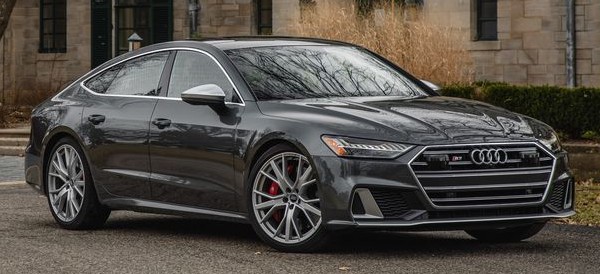
|
|
Downsizing
engine brings some compromises.
|
|
While European S7 turns to
TDI power, blame to the CO2 cap there,
American version retains gasoline power. However, it is downsized from
the previous V8 to V6 in the name of rationalization. This means from
now on V8 power is reserved for the range-topping RS7. Is it a backward
step?
Firstly, let’s look at the output figures: 450 horsepower and 442
pound-foot of torque. The former is virtually the same as the outgoing
4.0TFSI motor, while the latter is even 36 lbft up. How is this
possible? Obviously, the new V6 is not derived from the single-turbo
3.0TFSI unit that serves the lesser A7, but the 2.9-liter twin-turbo
unit the powers the RS5, and in different tune, Porsche Panamera 4S.
Read the figures again and you might assume that it is the same motor
as the RS5. Not only the peak power and torque figures are the same,
but they appear at exactly the same revs, i.e. 5700-6700 rpm for the
former and 1900-5000 rpm for the latter. However, this motor is
actually different. Apart from the 2 turbochargers sitting inside the
V-valley, it has added an electric supercharger at the left side of the
engine. The charger is connected downstream of the turbos and upstream
of the intercooler. Its function is to help spooling up the turbos
quicker, but not adding maximum boost, because while it can rev to
70,000 rpm, the turbos can spin to well over 200,000 rpm at maximum
boost. When the turbos are spooled up, the electric supercharger
returns to idle. This means, the maximum boost of 1.5 bar is generated
purely by the exhaust gas and it explains why the peak torque happens
at the same rev as the RS5 motor. However, if you inspect the torque
curve, you should find it rises more rapidly at very low revs, which
means better drivability.
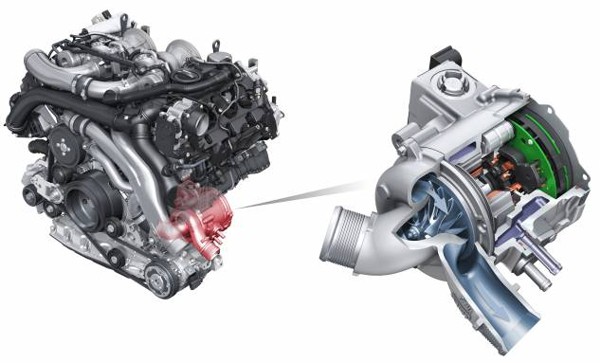
|
|
An
electric supercharger is added to the RS5's twin-turbo V6 to improve
drivability.
|
|
As in the case of S7 TDI, the electric charger is driven by the 48V
electrical system which powers also the car’s mild-hybrid system. It
captures braking energy to help acceleration or sustain coasting with
the engine shut down momentarily. The integrated starter-generator it
uses also doubles as the means for automatic stop-start. In addition to
the downsized engine, the new S7 returns 4mpg more than the old V8
model according to EPA.
That said, fuel economy comes with some compromises. The first to
suffer is sound quality, as no V6s can match a great V8. The second is
a faint turbo lag. Despite the help of electric supercharger, the 2.9
V6 runs a lot more boost than the 4-liter V8, so turbo lag is not
completely banished. In terms of performance, it is also a backward
step. Audi quotes 0-60 in 4.5 seconds, a tenth adrift of the old car.
Although the V6 produces more torque, it has exceeded the torque
capacity of the old car’s 7-speed S tronic (twin-clutch) gearbox, so it
changes to an 8-speed Tiptronic automatic. It is the same ZF 8HP unit
used in many BMWs and Jaguars, but Audi’s calibration is not quite as
skillful, resulting in slower gearshifts and a modest launch control.
The immense weight of S7 doesn’t help either.
In the end, the gasoline S7 remains a long-legged cruiser rather than
an outright performance car. It is designed for laid back driving
style, allowing its occupants to enjoy the composed ride of its air
suspension (don’t opt for steel springs and larger wheels), excellent
traction from Quattro and a relatively agile manner afforded by 4-wheel
steering and active differential. There is not much communication
through the steering, but let’s face it, the S7 is not a sports car.
|
Verdict:    |
Published
on 19
Feb 2020
|
All rights reserved.
|
|
Audi RS7
|
|
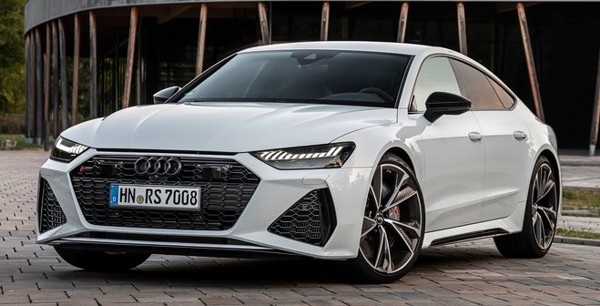
|
|
The
big coupe is surprisingly nimble for its size and weight...
|
|
Once again, the RS7 is
practically an RS6 Avant dressed in a 4-door coupe body. All the
underpinnings and performance options are shared between the 2 cars.
That might sound unamusing to the buyers of RS7, who should expect more
dynamism and speed. But think about this: for virtually the same money,
you can enjoy the aesthetic of a luxury coupe and the envy sight of
viewers, all the while without losing everyday driving comfort. The
only sacrifice is luggage carrying capability, but then again, the
RS7’s hatchback load bay is still very useful.
Speaking of looks, while the angular front end may split opinions with
its flamboyant styling, the RS7 is generally a handsome car, with a
long, wide and sleek profile. It looks especially beautiful from the
rear quarter. Fitted with optional, massive 22-inch wheels, and it
looks even better. The 20mm wheel arch extension at each side makes
its range-topping performance evident. The frameless windows and curvy
roofline achieve a dynamism omitted on the RS6, whose shape is boring.
As far as a 4-door luxury coupe is concerned, the Audi is the most
elegant design you can buy currently.
Despite that faster roofline, the RS7 is still a true 4 or 5-seater.
Adults, unless very tall, shall be pleased to settle into the rear
bench. Space and outward visibility aside, the interior is very much
like the RS6, or just any A6 and A7. It looks avantgarde and rich, if
not as luxury as a Bentley or Mercedes. High-tech and intuitive to use,
there is really nothing to complain about.
Rated at 600 hp and 590 lbft, the 4.0TFSI V8 is stronger again than the
old car, if not the outgoing Performance model. However, weight is also
up by 145 kg, so it is not a lot quicker. Still, 0-60 mph is
accomplished in
3.5 seconds, like its sedan cousin, while top speed is regulated at 190
mph with optional “dynamic package plus”. At speed, a tiny spoiler
rises from the tail to reduce aerodynamic lift.
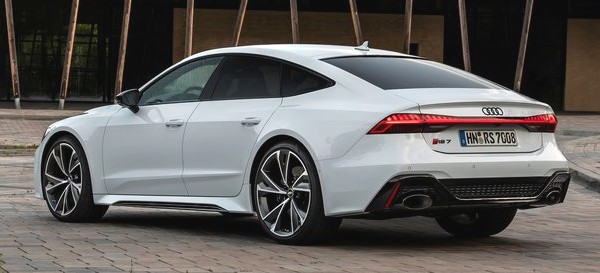
|
|
Few
could match it for long-distance high-speed travelling...
|
|
Although the drag coefficient is an unremarkable 0.32, the RS7 is well
insulated from wind as well as road noise. Its cabin is quiet in
high-speed cruising. The V8 always turns smoothly, as is the ZF 8-speed
automatic dubbed Tiptronic. Power delivery is very linear and flexible.
It is willing to pull from 2000 rpm to redline, but at no point it
feels particularly explosive. Such a refined manner is different from
its BMW and especially AMG rivals. There is little turbo lag, although
throttle response could be sharper. The V8 idles with a bassy rumble
and works quietly in normal driving. Even at a push, its sportier
exhaust note is never loud. It is therefore a good luxury high-speed
cruiser, if not the most entertaining. Speed is seen rather than heard
or felt, sometimes you might confuse it with a limousine.
Like RS6, the big coupe is surprisingly nimble for its size and weight.
The main reason is the new rear-wheel steering, but I would say equally
important is how Audi tuned and integrated its active rear
differential, active steering and adaptive suspension to work together.
It turns in eagerly, corners with little roll, and the chassis balance
is close to neutral. Understeer is well tamed, and you can push it to
oversteer at corner exit – though never as massive, sustainable or
adjustable as the AMG or M5 in rear-drive mode. Ultimately, you will
be still aware of its size and weight should you keep pushing hard.
However, compared with the old car, the new RS7 is far more athletic
and interesting to drive.
Compared with RS6 Avant, the slightly lower roofline makes no
discernible differences in handling because its suspension is neither
lower nor stiffer than its sedan cousin. So the choice is purely down
to your desire and needs.
As before, the RS7 offers the choice of adaptive air suspension or DRC
Dynamic Ride Control, which uses steel springs and hydraulically linked
adaptive dampers. The former is more comfortable, especially on
smoother and faster roads, while the latter is sportier. For RS6, we
prefer the DRC for its better control and more connected feel. However,
for the RS7, the air suspension is probably more likeable, because it
lets the car delivers a better ride refinement than the sportier AMG GT
4-door, and we expect the same to be true when BMW M8 Gran Coupe
arrives. If Audi cannot beat its rivals for sportiness, why not excel
in its own way? Yes, this is a fast, refined and well finished luxury
4-seater coupe. It is not the most agile or the most thrilling to
drive, but few could match it for long-distance high-speed travelling.
A true 4-door GT, in short.
|
Verdict:     |
|